|
 |
|
|
 |
 |
For 75 glorious years, Canada's Royal Winnipeg Ballet has carved out its worldwide reputation for standards of excellence, known equally for its "prairie freshness" and diverse programming that includes enduring romantic classics to cutting edge contemporary works. But its highly touted 2014/15 season-opener, Going Home Star – Truth and Reconciliation (GHS) choreographed by Mark Godden, a former company dancer and resident choreographer might well be the most important work created in its illustrious history as Canada's oldest troupe and North America's longest continuously operating ballet company. Ten years in the making, the mostly classical ballet performed en pointe was first envisioned in 2004 by local late Cree elder/activist Mary Richard and longtime artistic director André Lewis who wished to create an authentic, indigenous ballet in the long wake of its groundbreaking 1971 premiere of Norbert Vesak's The Ecstasy of Rita Joe. GHS is based on Canada's dark history of government-sanctioned residential schools, in which over 150,000 First Nations, Métis, and Inuit children were ripped from their blood families and forced into boarding schools designed to "kill the Indian in the child." The Truth and Reconciliation Commission of Canada (TRC) was established to seek answers, resulting in a formal apology by the Canadian government in June 2008 as a first step toward healing. The Montreal-based, Texas-born Godden created his newest ballet with the full support of the TRC, as well as the work's associate producer and "guide," Tina Keeper, a former Member of Parliament and TV star of CBC television's popular North of 60 series. With her own family deeply impacted by residential schools, Keeper's involvement added a critically important stamp of authenticity to the entire production. The nearly two-hour story ballet openly acknowledges Canada's painful legacy with its last residential school only closing in 1996 – coincidentally, the same year Lewis, a former RWB principal dancer took the helm. The fact that this tale is being told through the lens of a 400-year old European art form only serves as further testament to healing. Based on a story by Canadian novelist Joseph Boyden, GHS tells the tale of First Nations woman Annie (soloist Sophia Lee), a young urbanite hairdresser caught up in a downward spiral of clubbing and cocaine, hooking up in meaningless trysts with Random Lover (second soloist Tristan Dobrowney). After meeting homeless trickster Gordon (principal dancer Liang Xing), a survivor broken by his own past, she becomes spirited away to confront the devastating truth of the residential schools; witnessing first hand with him as stone-faced clergymen beat their young wards until both ultimately discover a sense of peace through reconciliation. Christos Hatzis' brilliant, tour de force score viscerally integrates Polaris-prize winning Inuk throat singer Tanya Tagaq, Steve Wood and the Northern Cree Singers with the Winnipeg Symphony Orchestra, led by Tadeusz Biernacki who superbly cues 700 pre-recorded samples mixed live with orchestra. The Toronto-based musician's multi-layered, electro-acoustic score, where mangled hymn tunes bleed into Tagaq's guttural vocalizations, or even a sly nod is paid to Swan Lake as Annie flies through the air in her dreams is now a game-changer as one of the finest ballet scores heard in years. Indigenous visual artist KC Adams' tour-friendly set design of cold brick walls contrasted with more naturalistic, suspended birch trees, arched whale bones that become a visual leitmotiv, and a giant, luminous turtle shell that eventually becomes a shelter for Annie and Gordon – now lovers - in Act II. Sean Nieuwenhuis' video projections of starry night skies, gently falling snow and hurtling tunnels through memory add texture and dimensionality while Pierre Lavoie's shadowy lighting underscores mood. Godden has always excelled at creating darkly dramatic characters, such as the brooding Svengali or tortured Dracula in his earlier RWB-commissioned ballets titled after the infamous anti-heroes. His generically titled Clergyman has now joined his nefarious club. Dressed in costume designer Paul Daigle's flowing black cassock, soloist Dmitri Dovgoselets filled the stage with terror every time he appeared, finally exploding like a volatile powder keg when whipping aboriginal child Charlie (soloist Yosuke Mino) that became almost unbearable to watch. His rape of young innocent girl Niska (corps member Alanna McAdie) at first appeared strangely subdued, but is now understood as the company consciously choosing to remain sensitive to actual survivors who attended performances during the ballet's five-show run held October 1 through 5, 2014. At times, GHS - its title referring to the celestial star that guides native travellers home - risks losing its own North Star. The plot-heavy narrative becomes obfuscated with its Act II scene depicting colonization - including its "Divine Louis" sextet of preening, Louis IV-esque dancers adorned with glittering mini-ship headpieces - teetered on didacticism. The choice to include recorded excerpts of survivor stories, ironically, upstaged and distracted from the choreography. Some of the story's symbolism doesn't always read clearly, and the tome-like, four-page plot synopsis is problematic for many reasons. Still, the newly re-energized company has never looked better. Its corps de ballet members performing as Urban Women and Men, Clergymen, the Divine Louis and Star Children showcase Godden's imitable choreographic melting pot of contemporary-infused flexed feet and cocked wrists juxtaposed with traditionally balletic pirouettes and battements. Both Lee and Xing in the lead roles - and with nary a second cast or any understudies in sight - also displayed their keen acting skills, with their performances as the ballet's two truth-seekers sharp and wholly believable. The two indigenous elders: Mother (soloist Yayoi Ban) and Father (corps member Thiago Dos Santos) serve as a moral presence, with their tearful parting scene with daughter Niska utterly heartbreaking. By providing ostensibly a bookend to The Ecstasy of Rita Joe, last staged in 2011, GHS marks a significant turning point for the company. Notably, the opening night crowd included aboriginal elders and members of the community - many whom are suspected of attending their first ballet production - mixed with regular RWB patrons who all leapt to their feet at the end. GHS also ensures the RWB's own place in dance history as arguably the world's first full-length indigenous ballet. Finally, as the country continues to grapple with an ever-increasing number of murdered and missing aboriginal women, its message of hope has never been more desperately needed. The RWB's bold choice to celebrate its diamond anniversary by honouring and giving voice to Canada's indigenous peoples through an ethereal, classically-based art form is remarkable in itself; that also proves ballet's lasting viability and relevance to all in the 21st century as it begins its next 75 years.
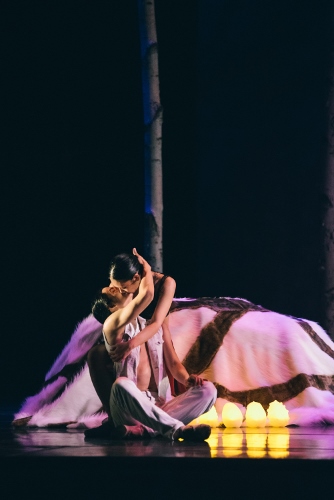 Liang Xing and Sophia Lee in "Going Home Star - Truth and Reconciliation". Photo © & courtesy of Samanta Katz |
|
 Liang Xing and Sophia Lee in "Going Home Star - Truth and Reconciliation". Photo © & courtesy of Vince Pahkala |
|
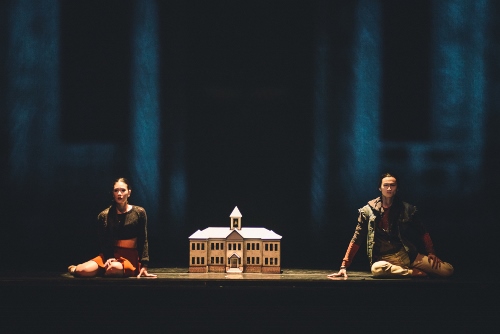 Liang Xing and Sophia Lee in "Going Home Star - Truth and Reconciliation". Photo © & courtesy of Samanta Katz |
|
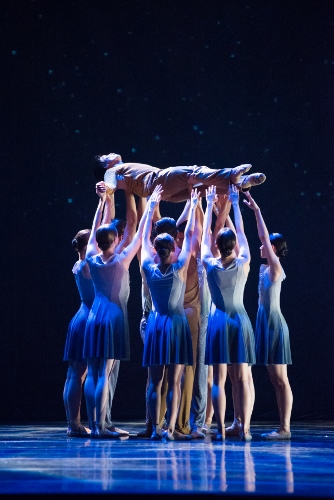 Royal Winnipeg Ballet dancers in "Going Home Star - Truth and Reconciliation". Photo © & courtesy of Samanta Katz |
|
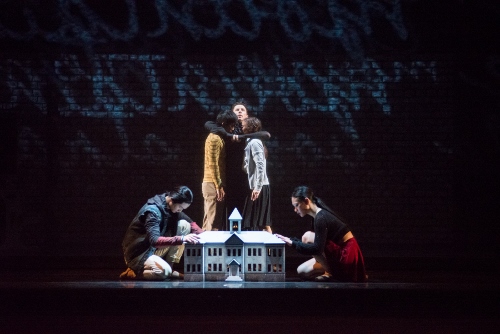 Royal Winnipeg Ballet dancers in "Going Home Star - Truth and Reconciliation". Photo © & courtesy of Samanta Katz |
|
 Royal Winnipeg Ballet dancer Yosuke Mino in "Going Home Star - Truth and Reconciliation". Photo © & courtesy of Samanta Katz |
|
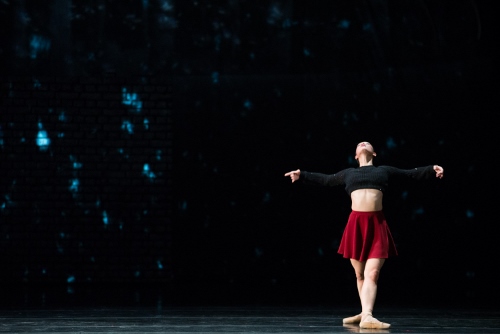 Royal Winnipeg Ballet dancer Sophia Lee in "Going Home Star - Truth and Reconciliation". Photo © & courtesy of Samanta Katz |
|
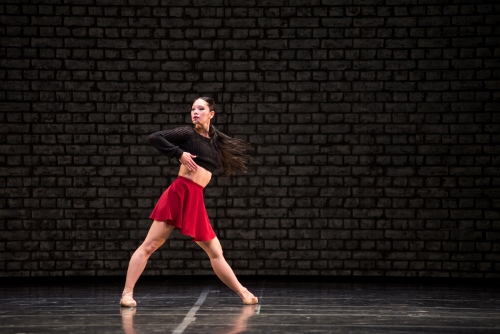 Royal Winnipeg Ballet dancer Sophia Lee in "Going Home Star - Truth and Reconciliation". Photo © & courtesy of Samanta Katz |
|
 Royal Winnipeg Ballet dancers Alanna McAdie and Sophia Lee in "Going Home Star - Truth and Reconciliation". Photo © & courtesy of Vince Pahkala |
|
|
|










